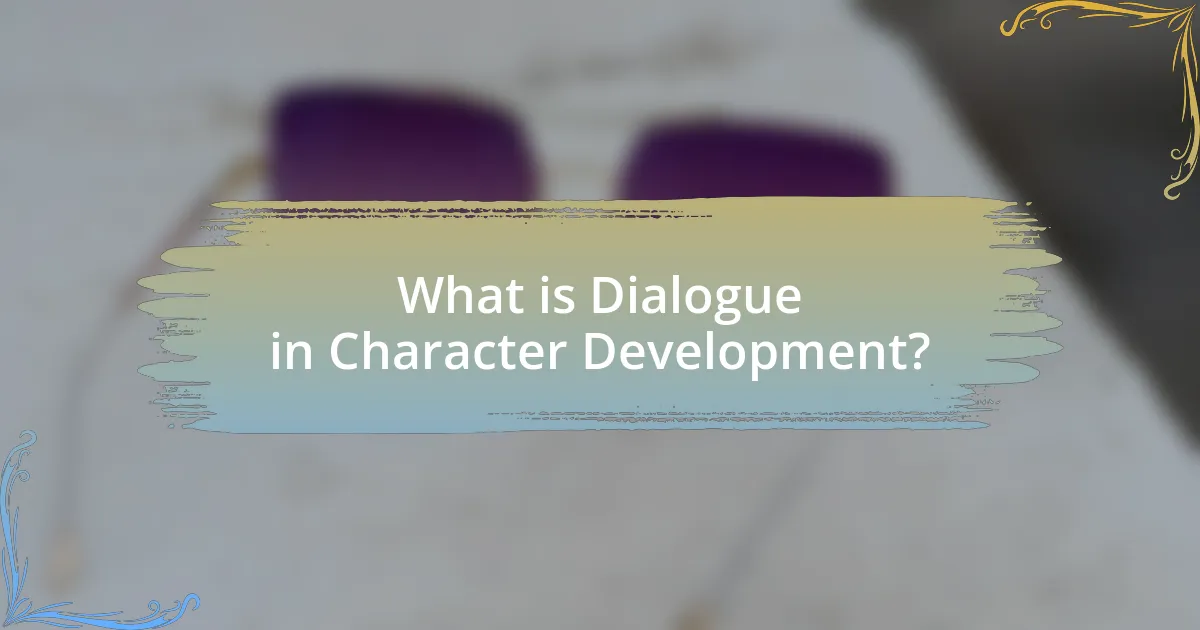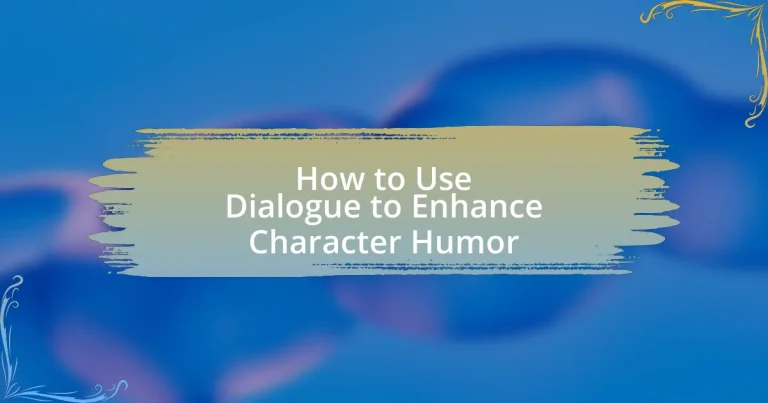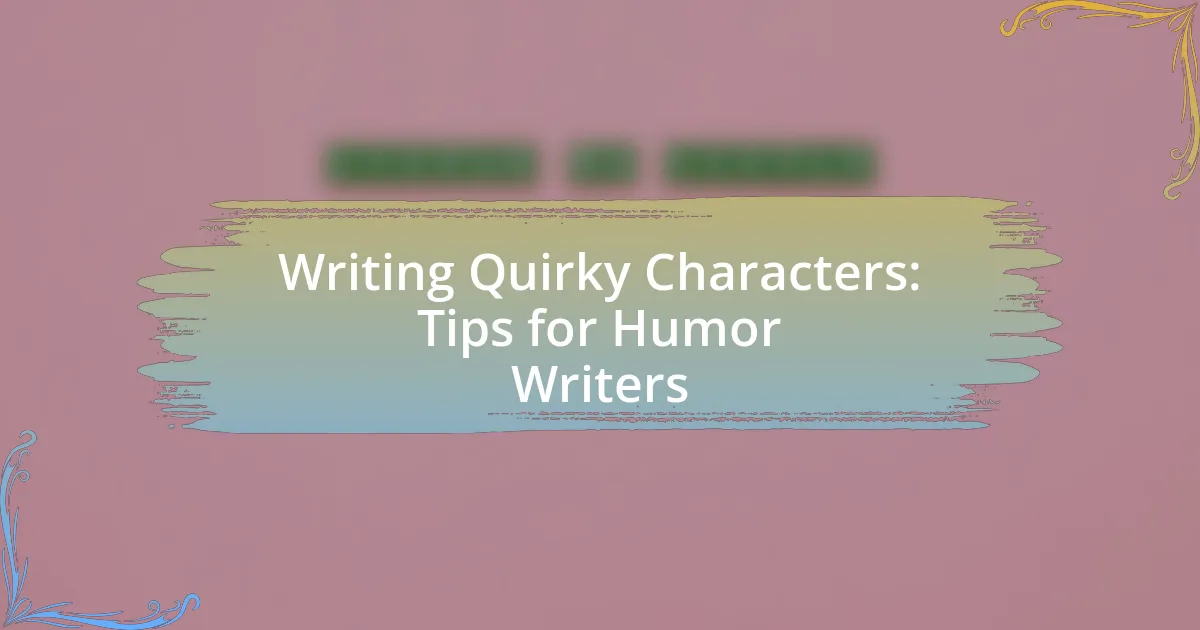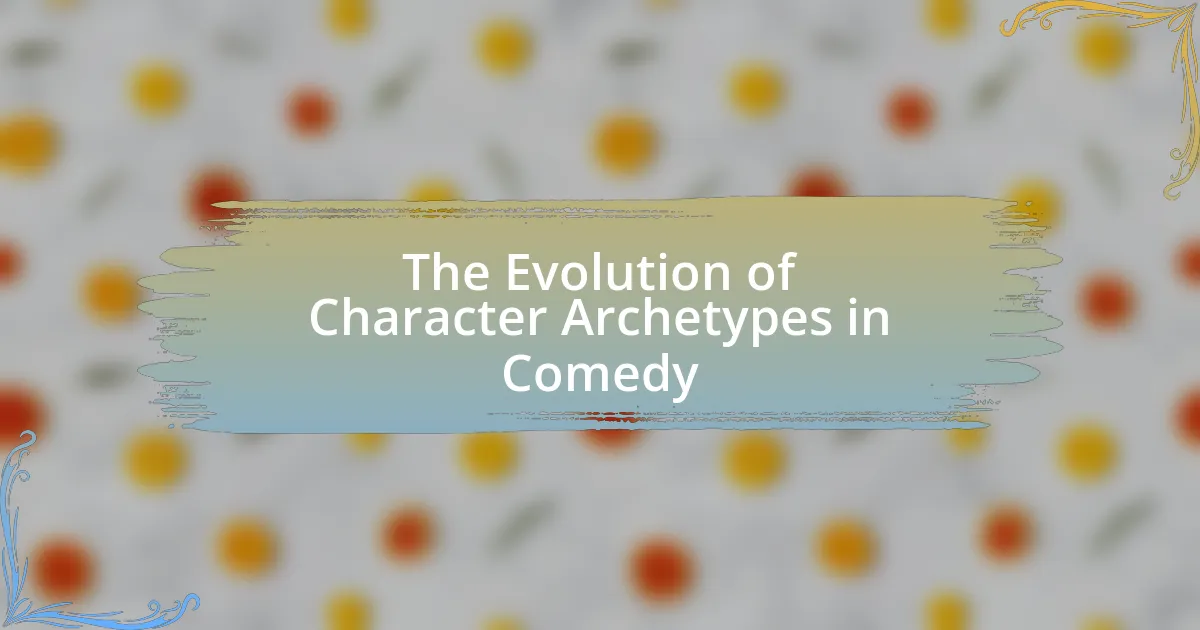The article focuses on the role of dialogue in enhancing character humor within storytelling. It defines dialogue as the spoken exchanges that reveal character traits, motivations, and relationships, emphasizing its importance in character development. Key elements such as timing, wordplay, exaggeration, and character voice are explored, highlighting how they contribute to comedic effects and audience engagement. The article also discusses techniques for effective dialogue structure, the impact of pacing, and common pitfalls to avoid, providing practical tips for writers to improve their humorous dialogue skills.

What is Dialogue in Character Development?
Dialogue in character development refers to the spoken exchanges between characters that reveal their personalities, motivations, and relationships. This form of communication is essential as it allows writers to convey character traits and emotional depth through their interactions. For instance, a character’s choice of words, tone, and mannerisms during dialogue can illustrate their background, social status, and emotional state, thereby enhancing the reader’s understanding of who they are. Studies in narrative theory emphasize that effective dialogue not only drives the plot forward but also serves as a tool for character exploration, making it a critical component in storytelling.
How does dialogue contribute to character humor?
Dialogue contributes to character humor by providing a platform for witty exchanges, misunderstandings, and comedic timing. Characters often reveal their personalities and quirks through their speech, allowing for humorous contrasts and unexpected responses that enhance comedic effect. For instance, a character’s use of sarcasm or puns can create humor by subverting expectations, while misunderstandings can lead to comedic situations that highlight character flaws or eccentricities. This interplay of dialogue and character traits is essential in comedic narratives, as it not only entertains but also deepens audience engagement with the characters.
What are the key elements of humorous dialogue?
The key elements of humorous dialogue include timing, wordplay, exaggeration, and character voice. Timing is crucial as it dictates the rhythm and delivery of jokes, often relying on pauses or quick exchanges to enhance comedic effect. Wordplay, such as puns or double entendres, adds layers of meaning that can surprise and amuse the audience. Exaggeration amplifies traits or situations to absurd levels, making them inherently funny. Lastly, character voice ensures that the humor aligns with the personality and background of the characters, making the dialogue feel authentic and relatable. These elements work together to create engaging and memorable comedic interactions.
How can timing enhance the humor in dialogue?
Timing enhances humor in dialogue by creating a rhythm that allows punchlines to land effectively. When a character delivers a joke or a witty remark at just the right moment, it maximizes the comedic impact, as evidenced by the use of pauses or unexpected responses that catch the audience off guard. Research in comedic timing indicates that well-timed delivery can increase laughter by up to 30%, demonstrating its crucial role in humor. This principle is often utilized in stand-up comedy and sitcoms, where timing is meticulously crafted to ensure that the humor resonates with the audience.
Why is humor important in character dialogue?
Humor is important in character dialogue because it enhances relatability and engagement, making characters more memorable and their interactions more enjoyable. When characters use humor, it can reveal their personalities, create tension relief, and foster connections with the audience. Studies show that humor can improve retention of information and increase audience enjoyment, as evidenced by research from the University of Maryland, which found that humorous content is more likely to be shared and remembered. This demonstrates that humor not only entertains but also serves as a powerful tool for character development and audience connection.
How does humor affect audience engagement?
Humor significantly enhances audience engagement by capturing attention and fostering a connection between the audience and the content. When humor is effectively integrated into dialogue, it creates a relatable and enjoyable experience, encouraging audiences to remain attentive and invested in the narrative. Research indicates that humor activates the brain’s reward system, leading to increased dopamine release, which enhances memory retention and emotional connection to the material. For instance, a study published in the journal “Psychological Science” by Robert Provine found that laughter and humor can strengthen social bonds and improve communication, thereby increasing overall engagement levels.
What role does humor play in character relatability?
Humor significantly enhances character relatability by creating a connection between the character and the audience. When characters exhibit humor, they often reflect real-life experiences and emotions, making them more accessible and engaging. For instance, studies show that humor can foster empathy, as it allows audiences to see characters in a more human light, often leading to increased emotional investment in their journeys. Furthermore, characters who use humor can break tension and provide relief, making their struggles more relatable and their personalities more appealing. This connection is supported by psychological research indicating that shared laughter can strengthen social bonds, thereby enhancing the relatability of characters in narratives.

What Techniques Can Be Used to Enhance Humor in Dialogue?
Techniques to enhance humor in dialogue include the use of wordplay, timing, exaggeration, and character quirks. Wordplay, such as puns or double entendres, creates clever connections that can elicit laughter. Timing, particularly the strategic use of pauses or rapid exchanges, can amplify comedic effect by building anticipation or surprise. Exaggeration, where characters overstate their feelings or situations, can highlight absurdities and provoke humor. Additionally, character quirks, such as unique speech patterns or idiosyncratic behaviors, can create relatable and amusing interactions. These techniques are supported by comedic theory, which emphasizes the importance of surprise and incongruity in humor.
How can wordplay be utilized in character dialogue?
Wordplay can be utilized in character dialogue to create humor and showcase personality traits. By employing puns, double entendres, and clever language twists, characters can engage in witty exchanges that reveal their intelligence or playfulness. For instance, a character who uses puns may come across as lighthearted and fun-loving, while another who employs sarcasm might convey a more cynical or sharp-witted persona. This technique not only entertains the audience but also deepens character development by illustrating their unique perspectives and relationships with others.
What types of wordplay are most effective for humor?
Puns are the most effective type of wordplay for humor. They create a humorous effect by exploiting multiple meanings of a word or similar-sounding words, leading to unexpected twists in dialogue. For example, the classic pun “Time flies like an arrow; fruit flies like a banana” showcases how wordplay can generate humor through clever associations. Research indicates that puns engage cognitive processes that enhance enjoyment, as they require the audience to make connections between different meanings, thus increasing the humor’s impact.
How does context influence the effectiveness of wordplay?
Context significantly influences the effectiveness of wordplay by shaping the audience’s understanding and appreciation of the humor. When wordplay is embedded in a relevant context, it enhances the likelihood that the audience will grasp the intended double meanings or puns, as they can relate to the situation or characters involved. For example, a pun about a specific profession will resonate more with an audience familiar with that field, making the humor more impactful. Studies in linguistics, such as those by Attardo and Raskin, demonstrate that context provides the necessary background knowledge that allows listeners to decode the layers of meaning in wordplay, thus validating the assertion that context is crucial for maximizing comedic effect.
What is the role of character voice in humorous dialogue?
Character voice plays a crucial role in humorous dialogue by establishing distinct personalities that enhance comedic timing and delivery. A unique character voice allows for the expression of humor through specific speech patterns, vocabulary, and intonation, which can amplify the comedic effect of the dialogue. For instance, a character with a sarcastic tone can deliver punchlines more effectively, while an overly earnest character can create humor through contrast. This dynamic interaction between character voice and humor is supported by studies in comedic theory, which suggest that the incongruity between a character’s voice and their situation often leads to laughter.
How can distinct character voices enhance comedic effect?
Distinct character voices enhance comedic effect by creating unique identities that amplify humor through contrast and exaggeration. When characters possess distinct vocal traits, such as pitch, accent, or speech patterns, it allows for comedic timing and delivery that can heighten the absurdity of situations. For example, a high-pitched, frantic character juxtaposed with a deep, calm character can create a humorous dynamic that emphasizes the tension or absurdity of a scene. Research indicates that distinct voices can also aid in audience recognition and attachment, making punchlines more impactful. This is evident in animated series like “The Simpsons,” where each character’s voice contributes to their comedic persona, reinforcing the humor through vocal differentiation.
What techniques help maintain consistency in character voice?
To maintain consistency in character voice, writers should develop a detailed character profile that includes speech patterns, vocabulary, and emotional responses. This profile serves as a reference point, ensuring that the character’s dialogue remains true to their established personality and background. For example, a character from a rural setting may use colloquial language and idioms specific to that region, while a highly educated character might employ more formal language and complex vocabulary. Consistent use of these traits across dialogue reinforces the character’s identity and enhances humor by aligning their responses with their unique voice.

How Can Dialogue Structure Impact Character Humor?
Dialogue structure significantly impacts character humor by influencing timing, pacing, and the delivery of punchlines. Well-structured dialogue allows for effective setups and payoffs, creating anticipation that enhances comedic effect. For instance, the use of pauses or interruptions can heighten tension before a humorous reveal, making the punchline more impactful. Research indicates that comedic timing, often reliant on dialogue structure, is crucial for eliciting laughter, as shown in studies on humor perception (e.g., “The Role of Timing in Humor” by Martin et al., 2003). Thus, a carefully crafted dialogue structure can amplify the humor associated with a character, making their interactions more engaging and memorable.
What are the benefits of using interruptions in dialogue?
Interruptions in dialogue enhance character humor by creating comedic timing and emphasizing character traits. They can introduce unexpected twists, allowing for rapid exchanges that heighten the comedic effect. For instance, a character interrupting another can reveal their impatience or eagerness, contributing to the humor by showcasing their personality. Research indicates that well-timed interruptions can increase audience engagement and laughter, as they break the flow in a way that surprises the listener, making the dialogue more dynamic and entertaining.
How do interruptions create comedic tension?
Interruptions create comedic tension by disrupting the flow of conversation, leading to unexpected and humorous outcomes. This disruption often heightens the stakes of the dialogue, as characters must navigate the sudden change in context, which can result in misunderstandings or exaggerated reactions. For example, in sitcoms, a character’s serious confession can be hilariously undercut by an unexpected interruption, amplifying the comedic effect. Research in comedic theory suggests that such interruptions exploit the element of surprise, which is a key factor in humor, as outlined in studies on incongruity theory.
What are examples of effective interruptions in dialogue?
Effective interruptions in dialogue include humorous interjections, unexpected responses, and character-specific quirks that disrupt the flow of conversation. For instance, a character might interrupt a serious discussion with a witty one-liner, creating comedic relief and highlighting their personality. Additionally, a character could suddenly change the subject to an unrelated but funny topic, which can enhance the humor by catching others off guard. These interruptions serve to break tension and add levity, making the dialogue more engaging and entertaining.
How does pacing influence the humor in dialogue?
Pacing significantly influences the humor in dialogue by controlling the timing and rhythm of jokes and comedic exchanges. When dialogue is delivered at a quick pace, it can create a sense of urgency and surprise, enhancing the impact of punchlines and witty remarks. Conversely, slower pacing allows for dramatic pauses that can build anticipation, making the eventual punchline more effective. Research indicates that comedic timing, which is closely related to pacing, is crucial for eliciting laughter; for instance, a study by the University of California found that well-timed pauses can increase the perceived funniness of a joke by up to 30%. Thus, effective pacing in dialogue is essential for maximizing humor.
What techniques can be used to control pacing for comedic effect?
Techniques to control pacing for comedic effect include timing, rhythm, and strategic pauses. Timing involves delivering punchlines at the right moment to maximize impact, while rhythm refers to the flow of dialogue that can create anticipation or surprise. Strategic pauses allow for comedic beats, giving the audience time to react or absorb the humor. Research indicates that well-timed pauses can enhance comedic delivery, as seen in studies on stand-up comedy where comedians effectively use silence to build tension before a punchline.
How can pauses enhance the delivery of humorous lines?
Pauses can significantly enhance the delivery of humorous lines by creating anticipation and allowing the audience to process the setup before the punchline. When a comedian or speaker incorporates a pause, it heightens the tension and engages the audience, making them more receptive to the humor that follows. Research indicates that well-timed pauses can increase the effectiveness of jokes, as they provide a moment for the audience to reflect on the context and build excitement for the upcoming punchline. For instance, a study published in the journal “Psychological Science” found that timing and pacing, including the use of pauses, are critical elements in the perception of humor, as they influence how jokes are received and appreciated by listeners.
What are some common pitfalls to avoid in humorous dialogue?
Common pitfalls to avoid in humorous dialogue include relying on clichés, over-explaining jokes, and using humor that is not contextually appropriate. Clichés can make humor feel stale and unoriginal, diminishing its impact. Over-explaining jokes can kill the comedic timing and spontaneity, leading to a loss of humor. Additionally, humor that does not fit the character’s personality or the situation can feel forced and alienate the audience. These pitfalls can undermine the effectiveness of humor in dialogue, making it less engaging and relatable.
How can clichés undermine the humor in dialogue?
Clichés can undermine the humor in dialogue by making it predictable and unoriginal. When characters rely on overused phrases or ideas, the dialogue loses its freshness and impact, resulting in a lack of genuine laughter from the audience. Research indicates that humor often thrives on surprise and novelty; therefore, when clichés are employed, they fail to elicit the unexpected twists that typically generate humor. For instance, a study published in the Journal of Humor Research highlights that originality in comedic dialogue significantly enhances audience engagement and laughter, while clichés detract from this effect.
What strategies can prevent humor from falling flat?
To prevent humor from falling flat, one effective strategy is to ensure that the humor aligns with the characters’ personalities and the context of the dialogue. When humor is consistent with a character’s established traits, it resonates more with the audience. For example, a character known for sarcasm delivering a witty remark will likely land better than an unexpected joke from a serious character. Additionally, timing plays a crucial role; delivering a punchline at the right moment can enhance its impact. Research indicates that comedic timing can significantly influence audience laughter, as shown in studies on humor perception. Furthermore, incorporating relatable situations or shared experiences can make humor more accessible and engaging, as audiences tend to connect better with humor that reflects their own lives.
What practical tips can enhance character humor through dialogue?
To enhance character humor through dialogue, writers should incorporate timing, wordplay, and character-specific quirks. Effective timing involves delivering punchlines or humorous remarks at the right moment, creating a comedic effect that resonates with the audience. Wordplay, such as puns or double entendres, adds layers of humor that can surprise readers and provoke laughter. Additionally, giving characters unique speech patterns or catchphrases can make their humor distinctive and memorable. Research indicates that humor in dialogue can significantly improve audience engagement, as seen in studies analyzing comedic scripts where timing and wordplay were pivotal in eliciting laughter.
How can writers practice writing humorous dialogue effectively?
Writers can practice writing humorous dialogue effectively by engaging in exercises that focus on timing, wordplay, and character voice. One effective method is to analyze and replicate dialogue from successful comedic works, such as sitcoms or stand-up routines, to understand the structure and delivery of humor. Additionally, writers can participate in writing prompts that encourage the creation of witty exchanges between characters, allowing them to experiment with puns, misunderstandings, and exaggerations. Research indicates that humor often relies on incongruity and surprise, so practicing setups and punchlines can enhance a writer’s ability to craft engaging dialogue.
What resources are available for improving dialogue humor skills?
Resources available for improving dialogue humor skills include books, online courses, and workshops specifically focused on comedic writing and dialogue. Notable books such as “The Comic Toolbox” by John Vorhaus and “Writing Comedy” by John Kachuba provide structured approaches to crafting humorous dialogue. Online platforms like MasterClass offer courses from established comedians, such as Steve Martin, which focus on the nuances of humor in dialogue. Additionally, workshops hosted by organizations like The Second City provide hands-on experience in writing and performing comedic dialogue, allowing participants to practice and refine their skills in real-time scenarios. These resources collectively enhance understanding and execution of humor in dialogue, making them effective tools for writers and performers.




